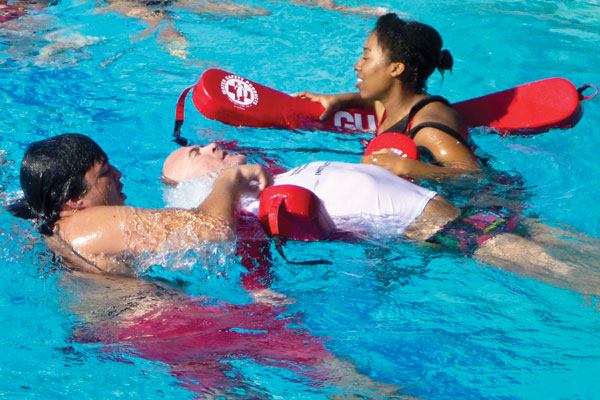My boss once referred me to a quote from Aristotle,“The whole is greater than the sum of its parts,” and one could say that a lifeguard team is based on this wisdom.
With that in mind, each team member believes in a shared set of rules:
- Rule 1: The lifeguard team consists of public servants who strive to ensure that everyone who visits their aquatics facility returns home safe and uninjured.
- Rule 2: Every lifeguard team member has value, based on their competencies.
- Rule 3: The team trains in preparation for the worst, knowing that complacency kills.
BVM ROTATION DRILL
(three or more lifeguards, preferably six or more)
Start with the bag valve mask fully assembled. All lifeguards stand in a line near the training station and have gloves to be used when working on the patient.
A lifeguard starts in the primary position (Position A) behind the patient’s head providing airway management with the BVM’s mask portion. Another takes the secondary position (Position B), to the patient’s side gripping the BVM bag with both hands.
During ventilations, a third lifeguard gloves up and prepares to step in. After the third ventilation, this guard will take over Position A with airway management. The lifeguard who was in Position A will take Position B, bagging the patient. The lifeguard who originally was in Position B degloves, and steps to rear of the line.
The drill ends when the lifeguard who started in Position B completes the role in Position A.
-
BVM ROTATION DRILL VARIATIONS:
The BVM is packaged and must be assembled by the primary and secondary lifeguards at the start of each rotation. Provide three BVMs (same timing).
- An additional BVM is packaged and must be assembled by the third lifeguard before stepping into the primary position. BVM must be assembled within the time of three ventilations. The newly assembled BVM is used for the ventilations. Provide three BVMs (same timing).
- The BVM is packaged and must be assembled by the primary and secondary lifeguards at the start of each rotation. The BVM is intentionally packaged without a mask. The lifeguard must use personal pocket mask as BVM mask replacement. Provide three BVMs. (same timing)
RECOGNITION DRILL:
The secondary lifeguard starts in a break room or office. The primary is in the water with a victim.
OBJECTIVE: Once the emergency action plan (EAP) is activated, the secondary lifeguard must be in the vacant lifeguard station in the ready position as quickly and safely as possible.
TIMING GOAL: 10 to 15 seconds to complete the objective.
Once proficient, add this: When secondary lifeguard is in the vacant lifeguard station, they must locate the primary, assess and verbally identify the situation. (Same timing):
- The primary lifeguard doesn’t need additional assistance, no action taken.
- The primary needs assistance in water.
- Secondary lifeguard identifies this as a critical incident, upgrades EAP for additional assistance and prepares emergency equipment.
ENTRY ASSISTANCE DRILL:
This follows the Recognition Drill with the secondary lifeguard in the break room. It starts when the primary lifeguard activates the EAP.
OBJECTIVE and TIMING GOAL: Listed with each variation.
- Once the secondary lifeguard identifies that assistance is needed, they upgrade the EAP, enter the water and assist. Objective: The secondary lifeguard makes physical contact with primary. (30 seconds)
- Victim is face down on water surface, unconscious. Primary lifeguard should have victim rolled over before the secondary lifeguard makes contact. The secondary assists in placing the victim into a towing position. Objective: both lifeguards and rescue tube(s) are in the proper position. (20 seconds)
- Victim is submerged. Objective: The secondary lifeguard must reach the primary before or just as the victim reaches the surface.(20 seconds)
- Start with variation three, add: Primary lifeguard assesses victim, while secondary supports. The primary announces, “Victim is not breathing, but has a pulse.” Two breaths are given, and victim begins to breathe. Objective: Both lifeguards and rescue tubes are in the proper position. (35 seconds)
PREPPING EMERGENCY EQUIPMENT DRILL:
These drills start with the activation of the EAP. The primary lifeguard is towing in an unconscious victim. Each of these variations should be practiced.
- The secondary lifeguard must upgrade the EAP, bring the backboard and be ready for extrication before the primary reacheds the side of pool. (Add 10 seconds or the time it takes to get the victim to the wall.)
- The secondary lifeguard must upgrade the EAP, bring backboard, along with AED, and be ready for extrication before primary lifeguard has victim to side of pool. Gloves must be on. (Add 15 seconds.)
- The secondary lifeguard must upgrade the EAP, bring the backboard, automated external defibrillator (AED) and BVM, and be ready for extrication before the primary has the victim to side of pool. BVM is assembled and gloves are on. (Add 15 seconds)
Remember: Although most lifeguard skills are demonstrated, taught and assessed on the ability of the single lifeguard, this does not mean those skills should only be done by a single lifeguard. Push yourself and your team. You might enjoy it.


